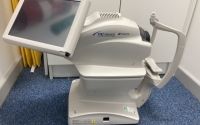


The A–B amplitude of the b-wave was less postoperatively (220.3 ± 52.7 and 210.3 ± 42.7 μV) compared to values before operation (248.1 ± 57.6 μV, P = 0.03 and P = 0.01, respectively). Results: Latency of the b-wave on the photopic electroretinogram was greater at each postoperative time point (30.5 ± 0.9 and 30 ± 1.3 ms), compared to preoperative values (29.2 ± 0.8 ms, P < 0.001 and P = 0.04, respectively).

Data were analysed using paired, one-tailed Student's t-test. The time at which postanaesthesia discharge score first exceeded 9 was also noted. Electroretinograms were recorded preoperatively, immediately after discharge from the recovery room and 2 h after discontinuation of sevoflurane. Methods: We performed full-field flash electroretinography in the right eye of 10 unpremedicated ASA I patients who underwent N 2O/sevoflurane anaesthesia. Background and objective: We tested the hypothesis that disturbances of the visual pathway persist following general anaesthesia, even after normal clinical discharge criteria have been met.


 0 kommentar(er)
0 kommentar(er)
